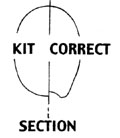Classic Airframe’s 1/48 Curtiss F11C-2/BFC-2 GoshawkBy Jim Schubert | 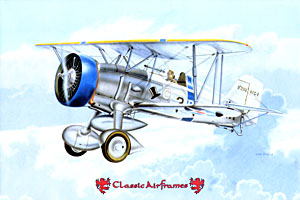 |
History
The Curtiss F11C-2/BFC-2 Goshawk ("Ghas-hawk", not "Gosh-hawk") was the penultimate Curtiss biplane fighter ordered by the US Navy. The last was the BF2C-1 retractable landing gear version of this same basic design. Michael Benolkin did a "First look" review of Classic Airframes' earlier kit of the BF2C-1 in the May 2000 issue of this magazine. 28 F11C-2s were ordered with all of them, save one, being delivered to the VF-1B "High Hat" squadron aboard USS Saratoga in February/March of 1933. All, therefore, had red tails signifying their residence aboard "Sara"; body band, cowling and wing chevron colors were standard for the section codings used as this time. One Goshawk, the 28th, was bailed back to Curtiss by the Navy for development work as the XF11C-3. In early 1934 all 27 of the F11C-2s were field modified with kits provided by Curtiss to become BFC-2s reaping the benefits of the work done with the XF11C-3. The visual evidence of this modification is the raised rear deck behind the pilot and the partial sliding hood, which was an interim compromise between traditional open cockpits and future fully enclosed cockpits. Tradition dies hard!
Leading Particulars:
Span: | 31.5' |
The Kit
Let's start with the negatives and get it over with. The forward fuselage has a serious cross sectional problem. Figure 1 shows, on the left, the kit cross-section at the dashed line in Figures 2 and 3 and on the right the correct cross section at that station. Built out-of-the-box the auxiliary fuel tank, or a bomb, cannot be properly positioned. Curtiss formed a large relief (dent) in the oil cooler air outlet (the rear dashed line in Figure 3) to permit fitting the tank, or bomb, closer to the fuselage to reduce drag. If you have one of the Monogram 1/72nd scale kits, #PA210, of the Curtiss F11C-2 Goshawk, originally released in 1968, you can look to it as a three dimensional reference for the proper contours in this area.
| Figure 1 | Figure 2 | Figure 3 | Figure 4 | Figure 5 |
That's the big one. A smaller one relates to the rear, white, running light. The kit has none. Figure 4 shows the Goshawk had a rear running light on either outboard LE of the stabilizer.
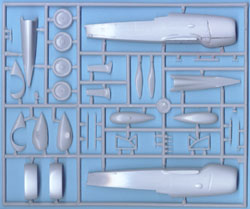 The kit does not have the flotation gear panels under the tips of the top wing. This omission is not really an error, because the instructions tell you to add them using .010" styrene and provides a pattern to help you. They did, however, miss the two small panels for servicing the flotation gear; see FIGURE 5. They tell you to use .010" sheet for the flotation panels, but that's way too thick. I'd use .005" sheet, or more simply Scotch tape, for both pairs of panels. All of these corrections apply equally to F11C-2 and BFC-2 Goshawks.
The kit does not have the flotation gear panels under the tips of the top wing. This omission is not really an error, because the instructions tell you to add them using .010" styrene and provides a pattern to help you. They did, however, miss the two small panels for servicing the flotation gear; see FIGURE 5. They tell you to use .010" sheet for the flotation panels, but that's way too thick. I'd use .005" sheet, or more simply Scotch tape, for both pairs of panels. All of these corrections apply equally to F11C-2 and BFC-2 Goshawks.
51 injection molded grey styrene parts come on two sprue trees to build up the basic model. 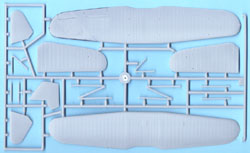 The detail and accuracy of these parts is, with the big exception noted above, quite acceptable. 23 resin parts provide the engine, cockpit and other details. Some of the small resin parts in my kit were broken. Two vac-formed clear windscreens and rear hoods are also provided to bail you out if you screw one up. The very well printed Microscale decal sheet provides markings for one F11C-2 and one BFC-2 of VF-1B and VB-3B respectively.
The detail and accuracy of these parts is, with the big exception noted above, quite acceptable. 23 resin parts provide the engine, cockpit and other details. Some of the small resin parts in my kit were broken. Two vac-formed clear windscreens and rear hoods are also provided to bail you out if you screw one up. The very well printed Microscale decal sheet provides markings for one F11C-2 and one BFC-2 of VF-1B and VB-3B respectively.
The seven pages of instructions provide a history, a parts map, a 12-step assembly guide and a rigging diagram.
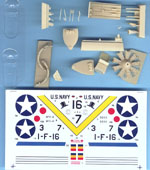 Throw away the kit's well printed, but grossly inaccurate color guide. It shows both airplanes, save for the top of the top wing and the tail group, in overall silver. At this time the Navy painted all the sheet metal areas grey and the fabric areas aluminum. Consult your preferred standard US Navy color references before selecting the colors and markings for the airplane you are going to model. If you do a later BFC-2 be aware the Navy changed its markings standards in 1937, which lets you do something other than red tails. Figuring out 1930s US Navy colors and markings can be very confusing; so be careful.
Throw away the kit's well printed, but grossly inaccurate color guide. It shows both airplanes, save for the top of the top wing and the tail group, in overall silver. At this time the Navy painted all the sheet metal areas grey and the fabric areas aluminum. Consult your preferred standard US Navy color references before selecting the colors and markings for the airplane you are going to model. If you do a later BFC-2 be aware the Navy changed its markings standards in 1937, which lets you do something other than red tails. Figuring out 1930s US Navy colors and markings can be very confusing; so be careful.
Conclusion
Apart from the cross sectional error, this kit is better than Classic Airframes' P-12/F4B-4 kits. If you study your references and correct the fuselage cross-section error you can build a beautiful "Golden Age" biplane from this new kit. Because of the common Curtiss wing and tailplane, I'll bet Classic Airframes is preparing a P-6E for us in the near future. That'll be great. I hope that they get around to doing the Boeing-Stearman and the Tiger Moth for us too in the near future. The world needs good kits of these popular trainers.
I bought the review sample from Emil Minerich's Skyway Model Shop in Seattle for $29.95 retail.
References
-
Curtiss Navy Hawks In Action: Bowers, Greer & Sewell, Squadron Signal Pubs. ISBN: 0-89747-342-6
-
Navy Air Colors, 1911-1945: Doll, Jackson & Riley, Squadron Signal Pubs., 1983, ISBN: 0-89747-143-1
-
The Curtiss Navy Hawks: Bowers, Profile Publications #116
-
The Curtiss Navy Hawks: Brian Baker, Dirty Plastic - Arizona Historical Modelers Society IPMS-Phoenix, 1978
-
IPMS/USA Quarterly Vol. 9, No. 1: Jim Maas' definitive article on 1930s US Navy colors
